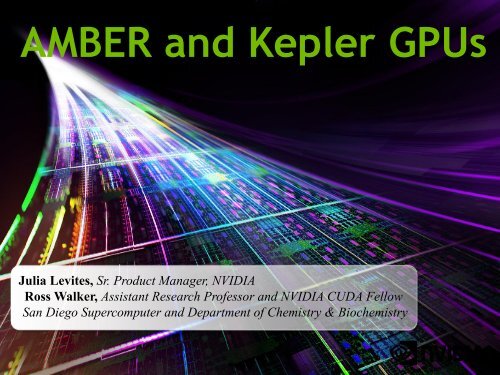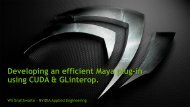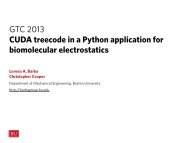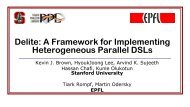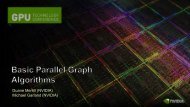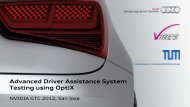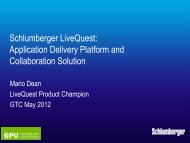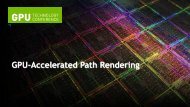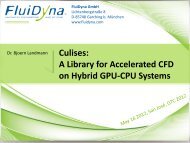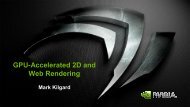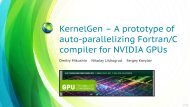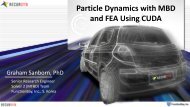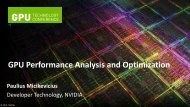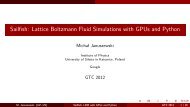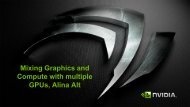presentation - GPU Technology Conference
presentation - GPU Technology Conference
presentation - GPU Technology Conference
Create successful ePaper yourself
Turn your PDF publications into a flip-book with our unique Google optimized e-Paper software.
AMBER and Kepler <strong>GPU</strong>sJulia Levites, Sr. Product Manager, NVIDIARoss Walker, Assistant Research Professor and NVIDIA CUDA FellowSan Diego Supercomputer and Department of Chemistry & BiochemistrySAN DIEGO SUPERCOMPUTER CENTER1
Walker MolecularDynamics Labhttp://www.wmd-lab.org/<strong>GPU</strong> AccelerationLipid Force FieldDevelopmentQM/MM MDAutomatedRefinementResearchers / Postdocs: Andreas Goetz, Romelia Salomon, JianYinGraduate Students: Ben Madej (UCSD/SDSC), Justin McCallum (ImperialCollege), Age Skjevik (UCSD/SDSC/Bergen), Davide Sabbadin (SDSC)Undergraduate Researchers: Robin Betz, Matthew Clark, Mike WuSAN DIEGO SUPERCOMPUTER CENTERUCSD2
What is Molecular Dynamics?• In the context of this talk:• The simulation of the dynamical properties of condensedphase biological systems.• Enzymes / Proteins• Drug Molecules• Biological Catalysts• Classical Energy Function• Force Fields• Parameterized (Bonds, Angles,Dihedrals, VDW, Charges…)• Integration of Newton’s equationsof motion.• Atoms modeled as points, electrons included implicitly within theparameterization.SAN DIEGO SUPERCOMPUTER CENTER3
Why Molecular Dynamics?• Atoms move!– Life does NOT exist at the global minimum.– We may be interested in studying time dependentphenomena, such as molecular vibrations, structuralreorganization, diffusion, etc.– We may be interested in studying temperature dependantphenomena, such as free energies, anharmonic effects,– etc.• Ergodic Hypothesis– Time average over trajectory is equivalent to an ensembleaverage.– Allows the use of MD for statistical mechanics studies.SAN DIEGO SUPERCOMPUTER CENTER4
Force FieldsSAN DIEGO SUPERCOMPUTER CENTER5
What is AMBER?An MD simulationpackage12 Versions as of 2012distributed in two parts:- AmberTools, preparatory and analysisprograms, free under GPL- Amber the main simulation programs,under academic licensingA set of MD forcefieldsfixed charge, biomolecular forcefields:ff94, ff99, ff99SB, ff03, ff11, ff12experimental polarizable forcefields e.g.ff02EPparameters for general organicmolecules, solvents, carbohydrates(Glycam), etc.in the public domainindependent from the accompanyingforcefieldsSAN DIEGO SUPERCOMPUTER CENTER6
The AMBER Development TeamA Multi-Institutional Research CollaborationPrincipal contributors to the current codes:David A. Case (Rutgers University)Tom Darden (NIEHS)Thomas E. Cheatham III (University of Utah)Carlos Simmerling (Stony Brook)Junmei Wang (UT Southwest Medical Center)Robert E. Duke (NIEHS and UNC-Chapel Hill)Ray Luo (UC Irvine)Mike Crowley (NREL)Ross Walker (SDSC)Wei Zhang (TSRI)Kenneth M. Merz (Florida)Bing Wang (Florida)Seth Hayik (Florida)Adrian Roitberg (Florida)Gustavo Seabra (Florida)Kim F. Wong (University of Utah)Francesco Paesani (University of Utah)Xiongwu Wu (NIH)Scott Brozell (TSRI)Thomas Steinbrecher (TSRI)Holger Gohlke (J.W. Goethe-Universität)Lijiang Yang (UC Irvine)Chunhu Tan (UC Irvine)John Mongan (UC San Diego)Viktor Hornak (Stony Brook)Guanglei Cui (Stony Brook)David H. Mathews (Rochester)Celeste Sagui (North Carolina State)Volodymyr Babin (North CarolinaState)Peter A. Kollman (UC San Francisco)SAN DIEGO SUPERCOMPUTER CENTER7
AMBER Usage• Approximately 850 site licenses (per version)across most major countries.SAN DIEGO SUPERCOMPUTER CENTER8
Why do we need Supercomputers?Lots of AtomsSAN DIEGO SUPERCOMPUTER CENTER11
Why do we need Supercomputers?Lots of Time Steps• Maximum time per step is limited by fastestmotion in system (vibration of bonds)= 2 femto seconds (0.000000000000002 seconds)(Light travels 0.006mm in 2 fs)• Biological activity occurs on the nano-second tomicro-second timescale.1 micro second = 0.000001 secondsSO WE NEED500 million steps to reach 1 microsecond!!!SAN DIEGO SUPERCOMPUTER CENTER12
Moving Molecular DynamicsForward?(at the speed of memory / interconnect?)SAN DIEGO SUPERCOMPUTER CENTER13
Just build bigger supercomputersBeliefs in moving to the exascaleAtheistHereticBeliever+++R, -P ++R, P +R, +PR = Node SpeedP = No. Nodes(Today)R, PTrue BelieverR, ++PLuddites-R, -PThe Problem: ImmediateFuture is somewhere here.Fanatic-R, +++P14
The Problem(s)• Molecular Dynamics is inherently serial.• To compute t+1 we must have computed allprevious steps.• We cannot simply make the system bigger sincethese need more sampling (although manypeople conveniently forget this).• 100M atoms = 300M degrees of freedom (d.o.f)• 10ns = 5,000,000 time steps = 60x less time steps than d.o.f.• We can run ensembles of calculations but thesepresent their own challenges (both practical andpolitical).SAN DIEGO SUPERCOMPUTER CENTER15
Better Science?• Bringing the tools the researcher needs into hisown lab.• Can we make a researcher’s desktop look like a small cluster (removethe queue wait)?• Can we make MD truly interactive (real time feedback /experimentation?)• Can we find a way for a researcher to cheaply increase the power ofall his graduate students workstations?• Without having to worry about available power (power cost?).• Without having to worry about applying for clustertime.• Without having to have a full time ‘student’to maintain the group’s clusters?• <strong>GPU</strong>’s offer a possible costeffective solution.SAN DIEGO SUPERCOMPUTER CENTER16
Requirements• Any implementation that expects to gainwidespread support must be:• Simple / transparent to use.• Scientists want science first.• <strong>Technology</strong> is the enabler, NOT the science.• Whichever path is the easiest will be the one which is taken.• Not make additional approximations.• Have broad support.• Have longevity (5+ years minimum).SAN DIEGO SUPERCOMPUTER CENTER17
The Project• Develop a <strong>GPU</strong> acceleratedversion of AMBER’s PMEMD.San DiegoSupercomputer CenterRoss C. WalkerFunded as a pilot project (1year) under NSF SSEProgram & renewed for 3more years. NVIDIAScott Le GrandDuncan PooleSAN DIEGO SUPERCOMPUTER CENTER18
Project Info• AMBER Website: http://ambermd.org/gpus/Publications1. Goetz, A.W., Williamson, M.J., Xu, D., Poole, D.,Grand, S.L., Walker, R.C. "Routine microsecondmolecular dynamics simulations with amber - part i: Generalized born", Journal of Chemical Theory andComputation, 2012, 8 (5), pp 1542-1555, DOI:10.1021/ct200909j2. Pierce, L.C.T., Salomon-Ferrer, R. de Oliveira, C.A.F. McCammon, J.A. Walker, R.C., "Routine accessto millisecond timescale events with accelerated molecular dynamics.", Journal of Chemical Theory andComputation, 2012, 8 (9), pp 2997-3002, DOI: 10.1021/ct300284c3. Salomon-Ferrer, R.; Case, D.A.; Walker, R.C.; "An overview of the Amber biomolecular simulationpackage", WIREs Comput. Mol. Sci., 2012, in press, DOI: 10.1002/wcms.11214. Grand, S.L.; Goetz, A.W.; Walker, R.C.; "SPFP: Speed without compromise - a mixed precision modelfor <strong>GPU</strong> accelerated molecular dynamics simulations", Chem. Phys. Comm., 2013, 184, pp374-380,DOI: 10.1016/j.cpc.2012.09.0225. Salomon-Ferrer, R.; Goetz, A.W.; Poole, D.; Le Grand, S.; Walker, R.C.* "Routine microsecondmolecular dynamics simulations with AMBER - Part II: Particle Mesh Ewald" , J. Chem. TheoryComput., (in review), 2013SAN DIEGO SUPERCOMPUTER CENTER19
Original Design Goals• Transparent to the user.• Easy to compile / install.• AMBER Input, AMBER Output• Simply requires a change in executable name.• Cost effective performance.• C2050 should be equivalent to 4 or 6 standard IB nodes.• Focus on accuracy.• Should NOT make any additional approximations wecannot rigorously defend.• Accuracy / Precision should be directly comparable to thestandard CPU implementation.SAN DIEGO SUPERCOMPUTER CENTER20
Version History• AMBER 10 – Released Apr 2008• Implicit Solvent GB <strong>GPU</strong> support released as patch Sept 2009.• AMBER 11 – Released Apr 2010• Implicit and Explicit solvent supported internally on single <strong>GPU</strong>.• Oct 2010 – Bugfix.9 doubled performance on single <strong>GPU</strong>, addedmulti-<strong>GPU</strong> support.• AMBER 12 – Released Apr 2012• Added Umbrella Sampling Support, REMD, Simulated Annealing,aMD, IPS and Extra Points.• Aug 2012 – Bugfix.9 new SPFP precision model, support for Kepler I,<strong>GPU</strong> accelerate NMR restraints, improved performance.• Jan 2013 – Bugfix.14 support CUDA 5.0, Jarzynski on <strong>GPU</strong>, GBSA.Kepler II support.SAN DIEGO SUPERCOMPUTER CENTER21
Supported Features Summary• Supports ‘standard’ MD• Explicit Solvent (PME)• NVE/NVT/NPT• Implicit Solvent (Generalized Born)• AMBER and CHARMM classical force fields• Thermostats• Berendsen, Langevin, Anderson• Restraints / Constraints• Standard harmonic restraints• Shake on hydrogen atomsSAN DIEGO SUPERCOMPUTER CENTERNew in AMBER 12• Umbrella Sampling• REMD• Simulated Annealing• Accelerated MD• Isotropic Periodic Sum• Extra Points22
Precision ModelsSPSP - Use single precision for the entire calculation with theexception of SHAKE which is always done in double precision.SPDP - Use a combination of single precision for calculation anddouble precision for accumulation (default < AMBER 12.9)DPDP – Use double precision for the entire calculation.SPFP – New! 1 – Single / Double / Fixed precision hybrid. Designed foroptimum performance on Kepler I. Uses fire and forget atomicops. Fully deterministic, faster and more precise than SPDP,minimal memory overhead. (default >= AMBER 12.9)Q24.40 for Forces, Q34.30 for Energies / Virials1.Scott Le Grand, Andreas W. Goetz, Ross C. Walker, “SPFP: Speed without compromise - a mixed precisionmodel for <strong>GPU</strong> accelerated molecular dynamics simulations”, Comp. Phys. Comm., 2012, in review.SAN DIEGO SUPERCOMPUTER CENTER23
Supported System SizesSAN DIEGO SUPERCOMPUTER CENTER24
Running on <strong>GPU</strong>s• Details provided on: http://ambermd.org/gpus/• Compile (assuming nvcc >= 4.2 installed)• cd $AMBERHOME• ./configure –cuda gnu• make install• make test• Running on <strong>GPU</strong>• Just replace executable pmemd with pmemd.cuda• $AMBERHOME/bin/pmemd.cuda –O –i mdin …If set process is exclusive mode is on for each <strong>GPU</strong>,pmemd just ‘Does the right thing’SAN DIEGO SUPERCOMPUTER CENTER25
PerformanceAMBER 12SAN DIEGO SUPERCOMPUTER CENTER26
800.00700.00600.00500.00400.00300.00200.00100.000.00TRPCage 304 Atoms198.62471.14721.34399.86519.02559.32585.20Implicit SolventPerformance(SPFP)As expected the performancedifferential is larger for biggersystems.Myoglobin 2492 AtomsNucleosome 25095 Atoms180.00160.00140.00120.00100.0080.0060.0040.0020.000.007.60103.58147.3978.11105.38156.45175.223.503.002.502.001.501.000.500.000.111.812.581.421.832.803.13SAN DIEGO SUPERCOMPUTER CENTERThroughput in ns/day27
Explicit Solvent Performance(JAC-DHFR NVE Production Benchmark)2xK20X1xK20X2xK201xK204xK10 (2 card)3xK10 (1.5 card)2xK10 (1 card)1xK10 (0.5 card)2xM2090 (1 node)1xM20901xGTX Titan4xGTX680 (1 node)3xGTX680 (1 node)2xGTX680 (1 node)1xGTX6801xGTX58096xE5-2670 (6 nodes)64xE5-2670 (4 nodes)48xE5-2670 (3 nodes)32xE5-2670 (2 nodes)16xE5-2670 (1 node)21.1352.9458.2843.7454.4641.5558.1950.2538.4967.0272.49102.1389.1395.5981.0997.9582.70101.3186.84Single < $1000 <strong>GPU</strong>111.34118.880.00 20.00 40.00 60.00 80.00 100.00 120.00 140.00Kepler K20 <strong>GPU</strong> Kepler K10 <strong>GPU</strong> M2090 <strong>GPU</strong> GTX <strong>GPU</strong> Gordon CPUSAN DIEGO SUPERCOMPUTER CENTERThroughput in ns/day28
Explicit Solvent Benchmark(Cellulose NVE Production Benchmark)2xK20X1xK20X2xK201xK204xK10 (2 card)3xK10 (1.5 card)2xK10 (1 card)1xK10 (0.5 card)2xM2090 (1 node)1xM20901 x GTX Titan4xGTX680 (1 node)3xGTX680 (1 node)2xGTX680 (1 node)1xGTX6801xGTX580128xE5-2670 (8 nodes)96xE5-2670 (6 nodes)64xE5-2670 (4 nodes)48xE5-2670 (3 nodes)32xE5-2670 (2 nodes)16xE5-2670 (1 node)1.122.052.672.953.263.16SAN DIEGO SUPERCOMPUTER CENTER3.753.734.334.340.00 1.00 2.00 3.00 4.00 5.00 6.00 7.00 8.00 9.004.735.395.305.455.726.14Kepler K20 <strong>GPU</strong> Kepler K10 <strong>GPU</strong> M2090 <strong>GPU</strong> GTX <strong>GPU</strong> Gordon CPU6.446.476.787.50Single < $1000 <strong>GPU</strong>7.567.85Throughput in ns/day29
Performance Example (TRP Cage)CPU 8xE5462 <strong>GPU</strong> C2050SAN DIEGO SUPERCOMPUTER CENTER30
Interactive MD?• Single nodes are now fast enough, <strong>GPU</strong> enabled cloud nodesactually make sense as a back end now.SAN DIEGO SUPERCOMPUTER CENTER32
Recommended HardwareSupported <strong>GPU</strong>s (examples, not exhaustive)Hardware Version 3.5• Kepler K20 / K20X• GTX TitanHardware Version 3.0• Kepler K10• GTX670 / 680 / 690Hardware Version 2.0• Tesla M2050/M2070/M2075/M2090 (and C variants)• GTX560 / 570 / 580 / 590• GTX465 / 470 / 480SAN DIEGO SUPERCOMPUTER CENTERC1060/S1070 / GTX280 etc also supported34
Graphics cardQuadro9%Other1%Don't know18%Tesla42%GeForce30%For the research group you belong to, please write in the specific card modelsif you know them.SAN DIEGO SUPERCOMPUTER CENTER35
Recommended Hardware• See the following page for continuous updates:http://ambermd.org/gpus/recommended_hardware.htm#hardwareSAN DIEGO SUPERCOMPUTER CENTER36
DIY 4 <strong>GPU</strong> SystemAntec P280 Black ATX Mid Tower Casehttp://tinyurl.com/a2wtkfr$126.46GIGABYTE GA-990FXA-UD7AM3+ AMD Motherboardhttp://tinyurl.com/b8yvykv$216.00SILVERSTONE ST1500 1500WATX12V/EPS12V Power Supplyhttp://tinyurl.com/alj9w93$299.99AMD FX-8350 Eight Core CPUhttp://tinyurl.com/b9teunj$189.15Corsair Vengeance 16GB(2x8GB) DDR3 1600 MHzDesktop Memoryhttp://tinyurl.com/amh4jyu$96.87Seagate Barracuda 7200 3 TB7200RPM Internal Bare DriveST3000DM001http://tinyurl.com/a4ccfvj$139.994of EVGA GeForce GTX 6804096 MB GDDR5http://tinyurl.com/d82lq8d$534.59 eachOr K20X or GTX TitanTotal Price : $3206.82Note cards in this system run at x8 so you can only run single <strong>GPU</strong> AMBER runs (but you can run 4 simultaneously at fullspeed) – If you want to be able to run MPI 2x<strong>GPU</strong> runs then only place 2 cards in the x16 slots.SAN DIEGO SUPERCOMPUTER CENTER37
Single WorkstationBased on Exxact Model Quantum TXR410-512R(Available as Amber MD Workstation with AMBER 12 preinstalled)(A) SuperServer Tower / 4U Convertible Chassis, Supports Up To 3x 5.25 InchBays, 8x 3.5 Inch Hot-Swap HDD Bays, Up To 4x Double-Width <strong>GPU</strong>, 1620WRedundant Power Supplies(B) SuperServer Intel Patsburg Based Motherboard, Supports Up To 2x SandyBridge EP (Socket R) Series CPU, 2x 10/100/1000 NIC, Dedicated IPMI Port, 4xPCIE 3.0 x16 Slots, 2x PCIE 3.0 x8 Slots, Up To 512GB DDR3 1600MHzECC/REG Memory(C) Intel Xeon E5-2620 2.00 Ghz 15MB Cache 7.20GT/sec LGA 2011 6-CoreProcessor (2)(D) Certified 4GB 240-Pin DDR3 SDRAM ECC Registered DDR3 1600 MHzServer Memory (8)(E) Certified 2TB 7200RPM 64MB Cache 3.5 Inch SATA Enterprise Class HDD in aRAID 1 Configuration (2)(G) GeForce GTX 680 4GB or GTX Titan or K20X 6GB 384-bit GDDR5 PCIExpress 3.0 Accelerator (4)(H) CentOS 6Price ~ $6,500 (GTX 680) $8,500 (GTX Titan)$20,000 (K20X)SAN DIEGO SUPERCOMPUTER CENTER38
Clusters# of CPU sockets 2Cores per CPU socket4+ (1 CPU core drives 1 <strong>GPU</strong>)CPU speed (Ghz) 2.0+System memory per node (GB) 16 to 32<strong>GPU</strong>s# of <strong>GPU</strong>s per CPU socketKepler K10, K20, K20XFermi M2090, M2075, C20751-2(4 <strong>GPU</strong>s on 1 socket is good to do 4 fast serial <strong>GPU</strong> runs)<strong>GPU</strong> memory preference (GB) 6<strong>GPU</strong> to CPU connectionServer storageNetwork configurationPCIe 2.0 16x or higher2 TB+Infiniband QDR or better (optional)Scale to multiple nodes with same single node configurationSAN DIEGO SUPERCOMPUTER CENTER39
AcknowledgementsSan Diego Supercomputer CenterUniversity of California San DiegoNational Science FoundationNSF Strategic Applications Collaboration (AUS/ASTA) ProgramNSF SI2-SSE ProgramNVIDIA CorporationHardware + PeoplePeopleRomelia Salomon Andreas Goetz Scott Le GrandMike Wu Matthew Clark Romelia SalomonRobin Betz Jason Swails Ben MadejSAN DIEGO SUPERCOMPUTER CENTERDuncan Poole Mark Berger Sarah Tariq40
AMBER User Survey – 2011<strong>GPU</strong> Momentum is Growing!AMBER machines<strong>GPU</strong>s andCPUs49%CPUs only50%Don'tknow1%2-3years6%<strong>GPU</strong> Experience1-2years22%Don'tknow8%Almost 1year34%Lessthan 6months30%49% of AMBER machines have <strong>GPU</strong>s85% of users have up to 2 years of <strong>GPU</strong> experienceSlide #41
Testimonials“The whole lab loves the <strong>GPU</strong> cluster.Students are now able to run AMBERsimulations that would not have beenfeasible on our local CPU-basedresources before. Research throughputthe group has been enhancedsignificantly.”Jodi HaddenChemistry Graduate StudentWoods Computing LabComplex Carbohydrate Research CenterUniversity of GeorgiaSlide #42
<strong>GPU</strong> Accelerated Apps MomentumKey codes are <strong>GPU</strong> Accelerated!Molecular DynamicsAbalone – <strong>GPU</strong> only codeACEMD – <strong>GPU</strong> only codeAMBERCHARMMDL_POLYGROMACSHOOMD-Blue – <strong>GPU</strong> onlycodeLAMMPSNAMDQuantum ChemistryABINITBigDFTCP2KGAMESSGaussian – in developmentNWChem – in developmentQuantum EspressoTeraChem – <strong>GPU</strong> only codeVASPCheck many more apps at www.nvidia.com/teslaappsSlide #43
Test Drive K20 <strong>GPU</strong>s!Experience The AccelerationRun AMBER on Tesla K20 <strong>GPU</strong>todaySign up for FREE <strong>GPU</strong> TestDrive on remotely hostedclusterswww.nvidia.com/<strong>GPU</strong>TestDriveSlide #44


